
A mushroom or toadstool is the fleshy, spore-bearing fruiting body of a fungus, typically produced above ground, on soil, or on its food source. Toadstool generally denotes one poisonous to humans.

Edible mushrooms are the fleshy fruit bodies of several species of macrofungi. Edibility may be defined by criteria including the absence of poisonous effects on humans and desirable taste and aroma. Mushrooms that have a particularly desirable taste are described as "choice". Edible mushrooms are consumed for their nutritional and culinary value. Mushrooms, especially dried shiitake, are sources of umami flavor.

Lingzhi, Ganoderma sichuanense, also known as reishi or Ganoderma lingzhi is a polypore fungus native to East Asia belonging to the genus Ganoderma.

Artomyces pyxidatus is a coral fungus that is commonly called crown coral or crown-tipped coral fungus. Its most characteristic feature is the crown-like shape of the tips of its branches. The epithet pyxidatus means "box-like"—a reference to this shape.

Pleurotus ostreatus, the oyster mushroom, oyster fungus, hiratake, or pearl oyster mushroom is a common edible mushroom. It is one of the more commonly sought wild mushrooms, though it can also be cultivated on straw and other media.

Laetiporus sulphureus is a species of bracket fungus found in Europe and North America. Its common names are crab-of-the-woods, sulphur polypore, sulphur shelf, and chicken-of-the-woods. Its fruit bodies grow as striking golden-yellow shelf-like structures on tree trunks and branches. Old fruitbodies fade to pale beige or pale grey. The undersurface of the fruit body is made up of tubelike pores rather than gills.

Fomitopsis pinicola, is a stem decay fungus common on softwood and hardwood trees. Its conk is known as the red-belted conk. The species is common throughout temperate Europe and Asia. It is a decay fungus that serves as a small-scale disturbance agent in coastal rainforest ecosystems. It influences stand structure and succession in temperate rainforests. It performs essential nutrient cycling functions in forests. As well as a key producer of brown rot residues that are stable soil components in coniferous forest ecosystems. It has been reported that mushrooms have significant antioxidant activity.

Phaeolus schweinitzii, commonly known as velvet-top fungus, dyer's polypore, dyer's mazegill, or pine dye polypore, is a fungal plant pathogen that causes butt rot on conifers such as Douglas-fir, spruce, fir, hemlock, pine, and larch. P. schweinitzii is a polypore, although unlike bracket fungi the fruiting body may appear terrestrial when growing from the roots or base of the host tree.

Hydnellum peckii is a fungus in the genus Hydnellum of the family Bankeraceae. It is a hydnoid species, producing spores on the surface of vertical spines or tooth-like projections that hang from the undersurface of the fruit bodies. It is found in North America, Europe, and was recently discovered in Iran (2008) and Korea (2010). Hydnellum peckii is a mycorrhizal species, and forms mutually beneficial relationships with a variety of coniferous trees, growing on the ground singly, scattered, or in fused masses.
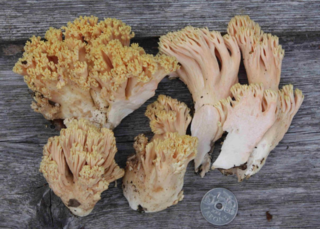
Ramaria formosa, commonly known as the salmon coral, beautiful clavaria, handsome clavaria, yellow-tipped- or pink coral fungus, is a coral fungus found in Europe. It is widely held to be mildly poisonous if consumed, giving rise to acute gastrointestinal symptoms of nausea, vomiting, diarrhea and colicky pain. It is a pinkish, much-branched coral-shape reaching some 20 cm (8 in) high. Similar forms collected in North America are now considered to represent a different species than the European Ramaria formosa.
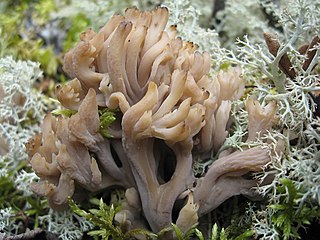
Clavulina cristata, commonly known as the white coral fungus or the crested coral fungus, is a white- or light-colored edible coral mushroom present in temperate areas of the Americas and Europe. It is the type species of the genus Clavulina.

Exsudoporus frostii, commonly known as Frost's bolete or the apple bolete, is a bolete fungus first described scientifically in 1874. A member of the family Boletaceae, the mushrooms produced by the fungus have tubes and pores instead of gills on the underside of their caps. Exsudoporus frostii is distributed in the eastern United States from Maine to Georgia, and in the southwest from Arizona extending south to Mexico and Costa Rica. A mycorrhizal species, its fruit bodies are typically found growing near hardwood trees, especially oak.

Ramaria botrytis, commonly known as the clustered coral, the pink-tipped coral mushroom, or the cauliflower coral, is an edible species of coral fungus in the family Gomphaceae. Its robust fruit body can grow up to 15 cm (6 in) in diameter and 20 cm (8 in) tall, and resembles some marine coral. Its dense branches, which originate from a stout, massive base, are swollen at the tips and divided into several small branchlets. The branches are initially whitish but age to buff or tan, with tips that are pink to reddish. The flesh is thick and white. The spores, yellowish in deposit, are ellipsoid, feature longitudinal striations, and measure about 13.8 by 4.7 micrometers.

Clavaria fragilis, commonly known as fairy fingers, white worm coral, or white spindles, is a species of fungus in the family Clavariaceae. It is synonymous with Clavaria vermicularis. The fungus is the type species of the genus Clavaria and is a typical member of the clavarioid or club fungi. It produces tubular, unbranched, white basidiocarps that typically grow in clusters. The fruit bodies can reach dimensions of 15 cm (5.9 in) tall by 0.5 cm (0.2 in) thick. Clavaria fragilis is a saprobic species, growing in woodland litter or in old, unimproved grassland. It is widespread throughout temperate regions in the Northern Hemisphere, but has also been reported from Australia and South Africa. The fungus is edible, but insubstantial and flavorless. There are several other small white coral-like fungi with which C. fragilis may be confused.

Clavaria zollingeri, commonly known as the violet coral or the magenta coral, is a widely distributed species of fungus. It produces striking tubular, purple to pinkish-violet fruit bodies that grow up to 10 cm (3.9 in) tall and 7 cm (2.8 in) wide. The extreme tips of the fragile, slender branches are usually rounded and brownish. A typical member of the clavarioid or club fungi, Clavaria zollingeri is saprobic, and so derives nutrients by breaking down organic matter. The fruit bodies are typically found growing on the ground in woodland litter, or in grasslands. Variations in branching and color can often be used to distinguish C. zollingeri from similarly colored coral fungi such as Alloclavaria purpurea and Clavulina amethystina, although microscopy is required to reliably identify the latter species.
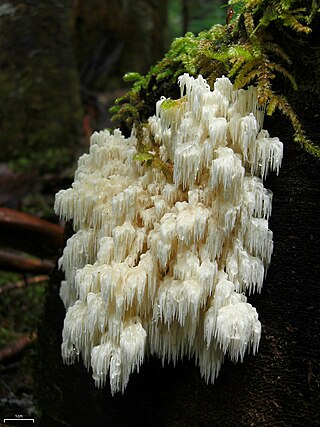
Hericium abietis, commonly known as the bear's head or the western coral hedgehog, is an edible mushroom in the tooth fungus group. It grows on conifer stumps or logs in North America, producing a cream white fruit body up to 10–75 cm (4–30 in) tall and wide. It fruits from after the start of the fall rains to mid-season.
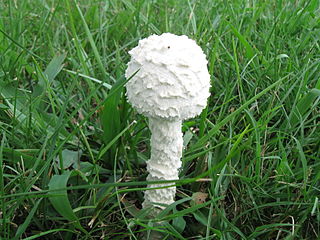
Saproamanita thiersii, commonly called Thiers' lepidella, is a North American saprotrophic basidiomycete fungus in the genus Saproamanita. It is a white, small mushroom. Its cap is convex, measuring 3.5–10 centimetres across, and the stipe is 8–20 cm (3–8 in) long. The spore print is white.
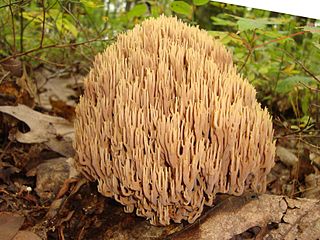
Ramaria stricta, commonly known as the strict-branch coral is a coral fungus of the genus Ramaria. It has a cosmopolitan distribution, and grows on dead wood, stumps, trunks, and branches of both deciduous and coniferous trees. Its fruit body is up to 10 cm tall, made of multiple slender, compact, and vertical parallel branches. Its color is typically light tan to vinaceous-brown. All parts of the mushroom will bruise when handled. There are several lookalike corals that can usually be distinguished from R. stricta by differences in coloration, bruising reaction, or microscopic features. The fungus is inedible due to its unpleasant odor and bitter taste.

Tremellodendropsis tuberosa, commonly known as the ashen coral, is a species of coral fungus in the family Tremellodendropsidaceae found in Europe, North America, South America, and Asia.

Ramaria magnipes is a coral fungus in the family Gomphaceae. It is found in western North America, where it fruits on the ground in mixed forests.




















